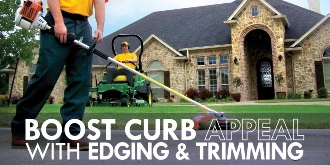Boost Curb Appeal with Edging & Trimming
A perfectly manicured landscape needs attention to two little details that can transform a ho-hum yard into a real attention-getter: edging and trimming. If you overlook these tasks, your yard will lack the finesse that distinguishes a sharply defined landscape from one with a blurry curb appeal. Take it from the landscape professionals at The Grounds Guys® -- lawn trimming and edging is just what the botanical doctor recommends as the cure for the common landscape.

So what's the difference between the two?
The differences between lawn trimming vs edging are:
- Lawn trimming makes horizontal cuts to remove grass and weeds in areas where your mower can't reach or where it may injure plants.
- Edging makes vertical cuts that define borders, walkways, islands and flower beds.
What equipment do you need?
Lawn trimming projects typically use string trimmers for quick and easy removal of grasses, weeds and other vegetation that grow around mailboxes, fences, trees and shrubs. Types of string trimmers include corded and cordless models, which are powered by gas, electric or batteries. Choose a battery-powered trimmer only if you have a small yard that needs only minimal trimming.
Edging projects typically use edgers that are mechanized, although you can use a manual rotary or half-moon edger if your lawn is small, your edging tasks are minimal and you have the elbow grease for the job.
Tips and Techniques
Lawn trimming
- Always wear eye protection when using a trimmer, shoes (or boots) and long pants to protect your feet and legs from flying debris.
- Match the height of the grass and weeds you cut with a trimmer to the height of the grass you mowed for a uniform look -- don't scalp the grass with a trimmer.
- Maintain the string length to the edge of the guard for safety.
- Choose a string trimmer with an automatic feed so you don't have to stop frequently and adjust the string.
- Don't allow the string of the trimmer to contact the trunk, stems, branches or bark of plants. Nicking plants while lawn trimming opens wounds that can allow insects and diseases to enter plants.
Edging
- Always wear eye protection when using an edger, shoes (or boots) and long pants to protect your feet and legs from flying debris.
- When edging along a hard surface, such as a sidewalk or driveway, position the wheel of the edger on the hard surface and use it as a guide as you cut into the grass along its edge.
- Use the edger's blade to make a 1- to 1 1/2-inch vertical cut into the soil.
- Don't use an edger against plastic edging, because it will cut the plastic and send shards flying.
- Be careful about using an edger around plant roots; be aware that the edger will severe the roots, which can injure a plant.
- If you want to install a new flower bed, you can use an edger to cut the outline into the yard before removing the grass inside the outline.
Cleanup and Storage
- Using lawn trimming and edging tools is only half the job. Be sure to remove the trimmings that fall onto your lawn and hardscapes to complete the manicure job.
- Store tools in a dry place to keep the blades sharp and keep them from rusting, and wipe or brush the blades clean before storing the tools. You'll extend the life of your tools with the proper care.
If you're new to lawn trimming and edging, start slowly and proceed with caution until you master the techniques. And be sure to contact The Grounds Guys with any questions you have - we're here to help!
 Click to call
Click to call


